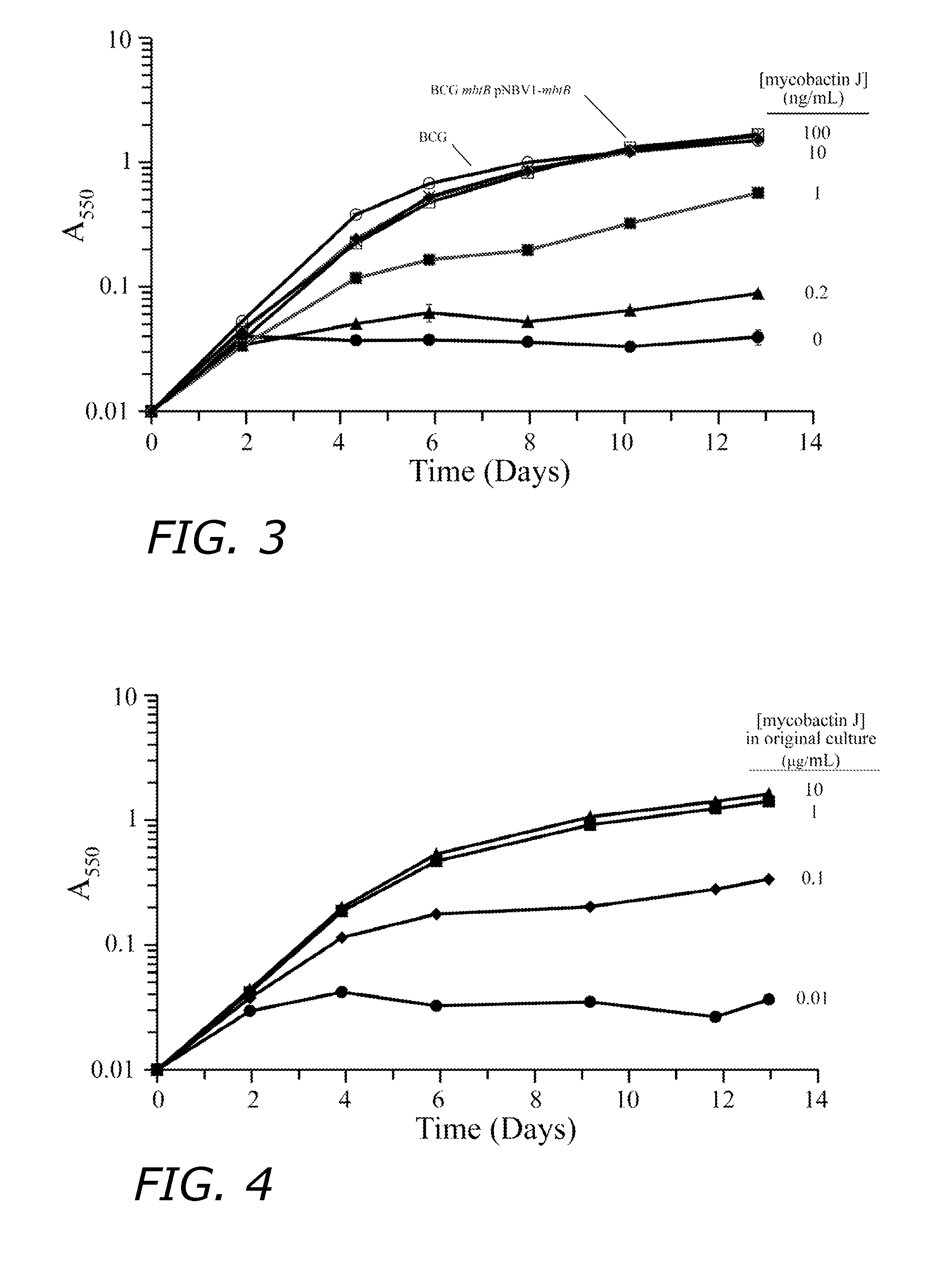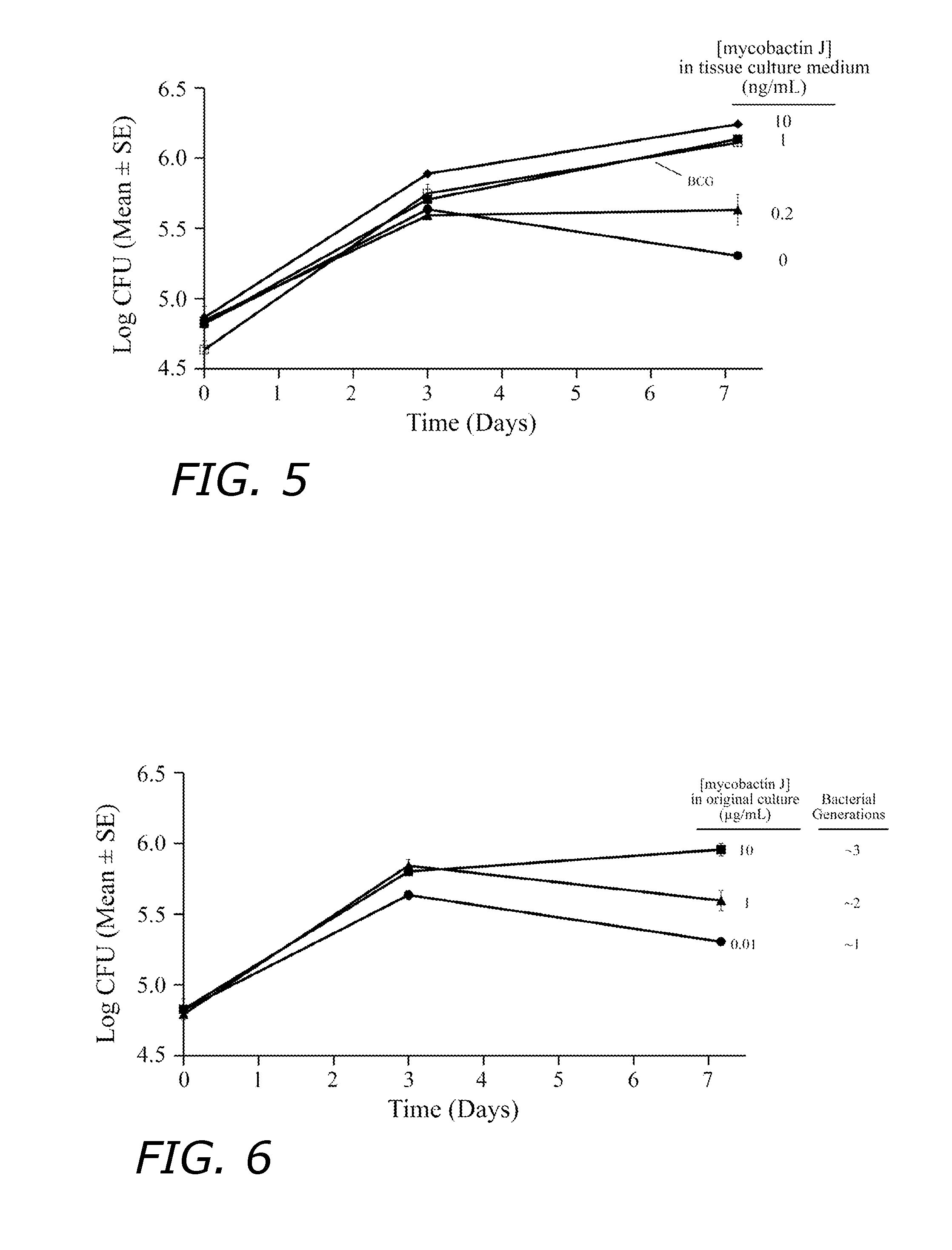Growth regulatable recombinant BCG compositions
a recombinant bcg and composition technology, applied in the field of immunogenic compositions, can solve the problems of limiting the universal effectiveness of therapeutic measures, causing immense suffering, and causing death,
- Summary
- Abstract
- Description
- Claims
- Application Information
AI Technical Summary
Benefits of technology
Problems solved by technology
Method used
Image
Examples
example 1
Studies of Growth of Auxotrophic Strains in vitro: rBCG(panCD) and rBCG(panCD)30 (pNBV1-30) Tice
[0099]The rBCG(panCD) and rBCG(panCD)30 strains are pantothenate (Vitamin B5) auxotrophs. In broth culture, rBCG(panCD) grew at a rate similar to the wild-type BCG strain in the presence of ≧10 μg mL−1 pantothenate. rBCG(panCD) displayed less than maximal intracellular growth in human macrophages when macrophages were cultured in standard tissue culture medium which contains 0.25 μg mL−1 pantothenate. Intracellular growth similar to the wild-type strain was achieved by adding an additional 100 μg mL−1 pantothenate (0.42 mM) to the tissue culture medium (FIG. 2, culture A was grown with 50 μg mL−1 pantothenate and culture B was grown with 500 μg mL−1 pantothenate prior to infection of the macrophages).
example 2
Studies of Growth-Restricted Strains in vitro: rBCG(mbtB) and rBCG(mbtB)30 II (pNBV1-30) Tice
[0100]The rBCG(mbtB)30 strain is mycobactin-dependent and thus it is defective in iron acquisition. Growth of the strain in broth is normal when supplemented with ≧10 ng / mL mycobactin J while growth is reduced at mycobactin J concentrations ≦1 ng / mL (FIG. 3). Although rBCG(mbtB)30 is dependent on exogenous mycobactin for growth, the strain can multiply for a limited number of generations after removal of mycobactin (FIG. 4). The number of generations of residual growth in the absence of mycobactin is dependent upon the level of mycobactin in the medium in which the strain was initially grown. When initially grown in broth supplemented with a high concentration of mycobactin J (10 μg / mL) and the cells washed, the strain is capable of approximately 10 generations of growth after subculture into medium lacking mycobactin J. When initially grown in broth supplemented with a low concentration of ...
example 3
Survival Studies of Auxotrophic and Growth-Restricted Strains In Vivo
[0102]The studies of the survival of the auxotrophic and growth-limited vaccine strains utilized guinea pigs because the guinea pig model is especially relevant to human tuberculosis. Furthermore, the wild-type BCG vaccine is known to undergo multiplication in guinea pigs prior to containment by the guinea pig's immune system. Multiplication of the BCG vaccine may be required for optimal immunity against tuberculosis.
[0103]Aliquots were removed from logarithmically growing wild-type or recombinant BCG cultures, and the bacteria were pelleted by centrifugation at 3,500×g for 15 min. The bacteria were then washed with 1× phosphate buffered saline (1×PBS, 50 mM sodium phosphate pH 7, 150 mM sodium chloride) and resuspended in 1×PBS to the desired concentration. The immunization inoculum contained from 103 to 107 viable wild-type or recombinant BCG bacteria in a total volume of 100 μl.
PUM
| Property | Measurement | Unit |
|---|---|---|
| concentrations | aaaaa | aaaaa |
| concentrations | aaaaa | aaaaa |
| concentration | aaaaa | aaaaa |
Abstract
Description
Claims
Application Information
 Login to View More
Login to View More - R&D
- Intellectual Property
- Life Sciences
- Materials
- Tech Scout
- Unparalleled Data Quality
- Higher Quality Content
- 60% Fewer Hallucinations
Browse by: Latest US Patents, China's latest patents, Technical Efficacy Thesaurus, Application Domain, Technology Topic, Popular Technical Reports.
© 2025 PatSnap. All rights reserved.Legal|Privacy policy|Modern Slavery Act Transparency Statement|Sitemap|About US| Contact US: help@patsnap.com



